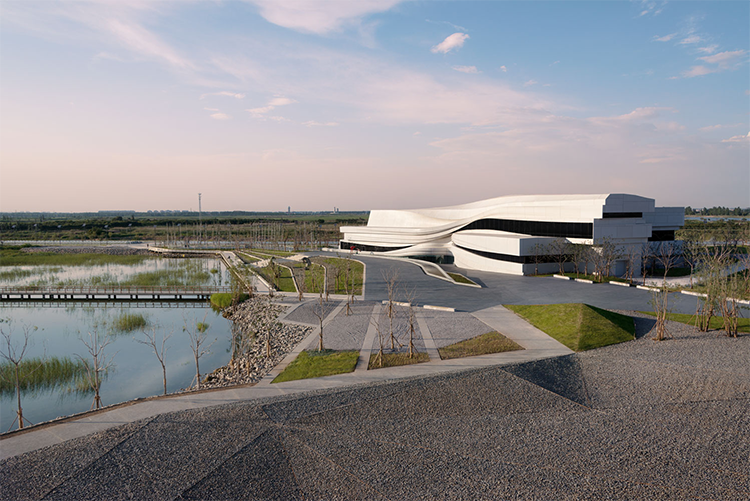MOCA Yinchuan: Discover Contemporary Art in China’s Desert Oasis
On the Yellow River banks in Yinchuan, Ningxia, a futuristic white building rises like a sculpture between desert and oasis—this is MOCA Yinchuan (Yinchuan Museum of Contemporary Art). As the first nonprofit contemporary art institution in northwest China, it serves as a laboratory for artistic experimentation and a bridge between local culture and global perspectives. Visiting here is a journey across time and space, where desert landscapes meet avant-garde ideas.
1. Birth of an Art Landmark: Cultural Awakening in the Desert
MOCA Yinchuan opened in 2015, designed by the internationally recognized firm WAA (We Architect Anonymous). The exterior features flowing curves and geometric cuts inspired by the Yellow River’s currents and the natural textures of the Helan Mountain rock art. From a distance it reads like a large piece of land art. The museum offers about 15,000 square meters of exhibition space with an 800-meter exhibition route that winds through galleries; light and shadow filter through a distinctive perforated structure, giving works a dynamic presence.
As the benchmark for contemporary art in China’s northwest, MOCA filled a long-standing regional gap and was named one of “China’s top ten emerging museums to watch” by ArtNews. Beyond exhibitions, the museum drives art education and research, drawing curators and art lovers from around the world each year.
2. Signature Works and Artistic Narratives: Local Voices, Global Dialogue
The collection focuses on Chinese contemporary art while incorporating international avant-garde work, emphasizing a balance of locality and globalization. Notable pieces and sections include:
– “Yellow River” installation series: Local artists reconstruct Yellow River imagery from reclaimed industrial materials, exploring the coexistence of ecology and civilization.
– International residency outcomes: Artists from Europe and the Middle East respond to northwest China’s landscape with striking cross-disciplinary works.
– Digital art zone: VR and interactive projections immerse visitors in worlds where virtual and physical realities merge.
Temporary exhibitions often tackle social themes—”Desert and the Future” addresses climate change, while “New Silk Road Narratives” reinterprets history through contemporary eyes. Labels next to works are in English, and QR-coded audio guides (Chinese and English) deepen understanding for international visitors.

3. Space and Atmosphere: Minimalist Contemplation
Visitors tend to be art professionals, young creators, and discerning travelers. The museum foregoes the solemnity of traditional museums, using white walls, high ceilings, and natural light to create a calm yet charged atmosphere. The best photo spot is the central atrium, where sunlight through the dome paints shifting patterns across the floor.
Galleries are organized along a “narrative loop”: explore “Local Experiments—International Dialogue—Future Exploration” in sequence. If time is short, head straight to the main second-floor galleries; for a full experience allow at least three hours and pause at the rooftop café to gaze toward the distant Helan Mountains through full-height windows.
4. Practical Visitor Information and Hidden Gems
– Opening hours: Tuesday–Sunday 10:00–17:00 (last entry 16:30). Closed on Monday.
– Tickets: Permanent collection 60 RMB; special exhibitions priced separately. Student discounts available. Foreign visitors can purchase tickets with passports; Alipay and WeChat Pay are accepted (international credit cards require on-site inquiry).
– Transportation: Approximately 30 minutes by car from central Yinchuan—taxi recommended (search “/ MOCA Yinchuan”). Alternatively, take bus No. 106 to Huaxia Hetu stop and walk about 10 minutes.
– Hidden extras:
– An outdoor “land art” area features large-scale installations set against desert scenery.
– Free artist talks every Saturday afternoon (advance reservation on the museum website required).
5. Nearby Pairings: A Full Day of Art and Nature
Combine MOCA Yinchuan with local sites for a rich day trip:
– Morning: Explore the museum and its contemporary programs.
– Lunch: Try Ningxia specialties and eight-treasure tea at the museum’s Moye Café .
– Afternoon: Drive 15 minutes to the Helan Mountain Rock Art site to see ancient petroglyphs—an evocative dialogue between prehistoric marks and contemporary art.

Conclusion
MOCA Yinchuan proves that art doesn’t have to be confined to major metropolises. Here, barrenness meets creativity and tradition meets the avant-garde. Whether you are a contemporary art enthusiast or a traveler eager to discover another side of northwest China, MOCA Yinchuan opens an unexpected window. Bring curiosity—and experience this desert oasis of art.


